Malcolm R. Campbell's Blog, page 207
March 1, 2015
New novella tells the story of a cat, a conjure woman and the KKK
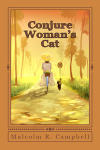
Click here for Kindle edition.
Thomas-Jacob Publishing has released Conjure Woman���s Cat,�� a novella by Malcolm R. Campbell (“The Sun Singer”), set in the 1950s Florida Panhandle world of blues, turpentine camps, root doctors, the KKK and a region of the state so far away from everywhere else that it���s often called ���the other Florida��� and ���the forgotten coast.”
Lena, a shamanistic cat, and her conjure woman Eulalie live in a small town near the Apalachicola River in Florida���s lightly populated Liberty County where longleaf pines own the world. Black women look after white children in the homes of white families and are respected, even loved as individuals, but distrusted and kept separated and other as a group.
A palpable gloss, sweeter than the state���s prized tupelo honey, holds the spiritual and temporal components of the Blacks��� and Whites��� worlds firmly in the stasis of their separate places. When that gloss fails, the Klan restores the unnatural disorder of ideas and people that have fallen out of favor.
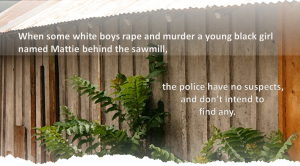
Click her to see the trailer.
Lena and Eulalie know the Klan. When the same white boys who once treated Eulalie as a surrogate parent rape and murder a black girl named Mattie near the saw mill, the police have no suspects and don���t intend to find any. Eulalie, who sees conjure as a way of helping the good Lord work His will, intends to set things right by ���laying tricks.���
Eulalie believes that when you do a thing, you don���t look back to check on it because that shows the good Lord one’s not certain about what she did. It���s hard, though, not to look back on her own life and ponder how the decisions she made while drinking and singing at the local juke were, perhaps, the beginning of Mattie���s ending.
All that���s too broke to fix, but beneath the sweet sugar that covers crimes against Blacks, Eulalie���s pragmatic, no-nonsense otherness is the best mojo for righting wrongs against both the world and the heart.
I hope you enjoy the book.
–Malcolm
Nook Edition at Barnes & Noble

Eulalie’s world.

February 25, 2015
Review: ‘Dance of the Banished,’ a story of WWI Turkish ethnic cleansing and Canadian hysteria
Dance of the Banished, by Marsha Forchuk Skrypuch, Pajama Press (February 1, 2015), young adult, 288 pages.
In her sixth book set during the Armenian Genocide, Marsha Forchuk Shrypuch���s Dance of the Banished brings young adult readers a heartbreaking account of the World War I-era ethnic cleansing in the Anatolia region of Turkey and the Canadian paranoia that sent thousands of purportedly dangerous immigrants to internment camps.
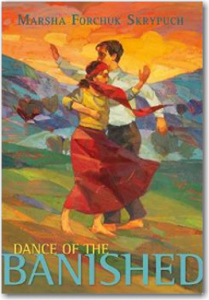 Armenians, who are traditionally Christian, and Alevi Kurds, whose religious views differ from those of Sunni Kurds, predate the arrival of the Turks in Anatolia. The discord brought into the region by the Turks is a centuries-old fight. ���Dance of the Banished��� begins in 1913 on the brink of Turkey���s entry into World War I on the side of the Central Powers with the story of two betrothed Alevi Kurds who are soon separated by hard times and a very wide ocean.
Armenians, who are traditionally Christian, and Alevi Kurds, whose religious views differ from those of Sunni Kurds, predate the arrival of the Turks in Anatolia. The discord brought into the region by the Turks is a centuries-old fight. ���Dance of the Banished��� begins in 1913 on the brink of Turkey���s entry into World War I on the side of the Central Powers with the story of two betrothed Alevi Kurds who are soon separated by hard times and a very wide ocean.
Ali chooses to go to Ontario, Canada where jobs are available. He plans to send money home to his family and to save enough to ultimately pay for Zeynep���s passage to Ontario. She views his departure as a betrayal, as practical as it may be, and wonders if they will ever see each other again.
Subsequently, Zeynep also leaves town to work in a hospital in a Harput, a city between the Tigris and Euphrates rivers, where she is swept up into the horror of revolution, war and poverty. Ali begins work in Canada only to find himself rounded up on trumped up charges and sent to a prison camp where he���s pressed into service at a minimal age. Both wonder why they don’t hear from each other.
The book���s sections, which alternate between Zeynep���s and Ali���s stories, are presented as journal entries written in the form of letters to each other. In time, she learns that the Armenians who have been allegedly drafted to fight in World War I are being exterminated and he learns that he is part a growing group of imprisoned Ukrainians, Turks and others who came to Canada for freedom only to end up without it.
The power of this novel comes in part from the age of its two protagonists and how their view of the world is forced to change. Young and in love, they see life through a different lens than their parents and grandparents. While their focus is on being reunited with each other, their journal entries begin with typical day-to-day activities and then change from initial disbelief at the persecution around them into grim accounts of their own involvement and means of survival.
Their growing horror and their continuing hope and perseverance during the cruel years of 1913 to 1917 combine for a poignant love story and a stark account of genocide close up and very personal.
The book is enhanced by the inclusion of internment camp pictures and an author’s note about the story’s historical background.
–Malcolm
Malcolm R. Campbell is the author of the upcoming novella “Conjure Woman’s Cat.”

February 24, 2015
Perhaps we’ve lost too much of the magic
“‘The ancient world was full of magic,’ writes novelist C.J. Cherryh.�� ‘Most everyone north and northwest of the Mediterranean believed that standing barefoot on the earth gave you special knowledge, that the prickling feeling at the back of your neck meant watchers in the wood, and that running water cleansed supernatural flaws.'”
–On Myth and Magic in Terri Windling’s post
Since we, as a world, have grown up, most people no longer believe this; or, if they do, they don’t admit it.
Ignorant superstition or pagan religion: that’s how such ideas are often categorized.
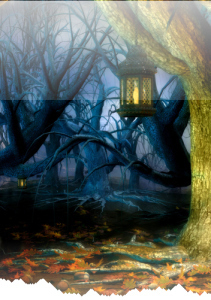 In one of my novels, I said that we’d exchanged magic and wonder for science and technology. Goodness knows, there have been benefits to some of that. But it seems a little skewed to me.
In one of my novels, I said that we’d exchanged magic and wonder for science and technology. Goodness knows, there have been benefits to some of that. But it seems a little skewed to me.
Too little magic. Too much technology. Some say, that our technology will one day rule us (literally, not figuratively as it does now) and will become so self-aware that it (the computers and machines) will decide that humans are no longer needed.�� Kind of like the Terminator movies.
I’m subversive when it comes to magic. I put it in my fantasy novels where it seems almost natural enough to be real. I hope some readers think it’s real by the time they finish the books. If not that, I hope they are willing top ponder the question of its reality with open minds.
Perhaps we’ve most too much of the magic because we never believed enough in ourselves as individuals. Did we assume scientists, inventors, governments and corporations knew more about everything than we did? Did we see ourselves as too small to trust what our hearts suggested to us?
Hard to say. The magic discussion can get very circular because it’s often said, you won’t find magic if you don’t believe in it. That may be true, but it’s also convenient because it’s a false method of trying to prove a point.
Maybe we don’t have to believe in magic to find it. Maybe all we have to do is entertain the possibility that it’s there. It’s not too difficult to walk barefoot across a field or a beach and see what happens. Naturally, doing that with our arms crossed and our minds cynical isn’t going to help. Better to play. To dance there or enjoy the scenery with all of our logic on hold.
In my stories, I suggest magic is there waiting for characters to see it. Some do, some don’t. Maybe those who see it are crazy fools, but what if they’re not? If we dismiss things out of hand, we’ll never know.
–Malcolm
Malcolm R. Campbell is the author of the upcoming folk magic novella “Conjure Woman’s Cat.”
February 22, 2015
Why do writers write what they write?
We’re told to write what we know. That doesn’t stop us from doing research and ending up knowing more. Perhaps what we know and what we want to learn about play into the list of things we care about.
I’m not talking about caring about mom and apple pie or caring about getting rid of war, poverty and prejudice, though those things are good to care about. What writers care about is often a mix of locations, themes, character types, story types and the related issues that attract their attention.
My earliest passions–other than having a slice of apple pie with a healthy slab of sharp cheddar cheese–were nature and psychic phenomena. Family vacations and Boy Scout camping trips introduced me to a lot of wild places and what it took to live in the woods. Books introduced me to intuition, transcendent experiences, improving one’s natural hunches and the kinds of things that might go bump in the night.
Perhaps this is why I write fantasy and magical realism with a strong sense of the natural world that surrounds my stories and characters.
A belief in unseen worlds and inner transformation turned me into the kind of person who detests conformity, authoritarian and/or patriarchal control of individuals, and brute-force lawless action whether it manifests in the KKK and Jim Crow, the Armenian genocide, Hitler or ISIS.
I grew up in Florida, a state that made its living and fame off of orange groves and tourist attractions. At the same time, the state was in the “top five” when it came to lynchings, Klan activity and corrupted government officials. Florida, to my mind, equals nature that has been compromised by development and a very ugly past that nobody likes to talk about.
I have a fondness for longleaf pines, blackwater rivers, Gulf Coast estuaries and beaches. I have an inherent dislike of the Klan because they were the devil I knew and feared as a child even though I am white.
All of these things led me to write my upcoming novella Conjure Woman’s Cat, a book about the natural world, folk magic, 1950s-era discrimination and the Klan.
The ever-popular question where do you get your ideas is one I detest because most people who ask it are doing so in an interview, or perhaps in an elevator, and expect a short answer such as “in the newspaper” or “from people watching” or “from my grandfather’s stories.”
The real answer is so much more complex that I don’t know how to put it into a 25-word answer that satisfies anybody. Ideas come from years of feeling strongly about one thing and another until somehow a story idea springs out of “nowhere” and I start writing.
This doesn’t add up to any recipe advice for people who want to write. Recipe advice tends to do more harm than good anyway. The real advice is to nurture oneself, follow one’s intuition and harvest all of that into a mix that accentuates one’s favorite (good or bad) areas of interest. And then, no matter what you believe, try not to preach, allowing the story to speak for itself.
–Malcolm
Malcolm R. Campbell is the author of the fantasy novels “The Seeker,” “The Sailor,” and “The Betrayed” and the paranormal short stories “Moonlight and Ghosts,” “Cora’s Crossing,” and “Emily’s Stories.”

February 18, 2015
Briefly Noted: ‘On The Big Rivers’
On the Big Rivers: From Three Forks, Montana to New Orleans Louisiana by�� Richard E. Messer, with Jerry D. Sanders, Genoa House (Feb 21, 2015), 190 pp., photographs.
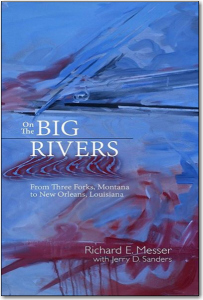 Rivers are the veins of the Earth. I’ve seen the Missouri and the Mississippi from my car and from the air. But to travel them: that would be the experience to savor and write about as author William Least Heat-Moon wrote about his trip across the U.S. by boat in River Horse in 1999. Now, here’s a canoe trip to savor.
Rivers are the veins of the Earth. I’ve seen the Missouri and the Mississippi from my car and from the air. But to travel them: that would be the experience to savor and write about as author William Least Heat-Moon wrote about his trip across the U.S. by boat in River Horse in 1999. Now, here’s a canoe trip to savor.
From the Publisher
“Canoeing from the source of the Missouri River high in the mountains of the Continental Divide down the rapids and over the dams of the upper Missouri to its confluence with the Mississippi and on down its broad waters to New Orleans, 3,800 miles, two young men undertake a voyage of adventure that every young person talks about, but few take. Travel with them in a time before cell phones and GPS as they are initiated into the age old perils of nature and explore the historic river towns along their route.
“Experience through vivid, first person story telling, the physical and emotional challenges they meet and overcome in their encounters on this pioneering journey down the two greatest rivers of America. This exciting narrative provides not only a pristine view of the beauties of these rivers as they were fifty years ago, but also dramatizes the damage we have done in contaminating, straightening, and commercializing our once bounteous water resources. Share this dream of inspiring adventure and experience the pioneering spirit that still lives in every young heart.”
You may also like: ���On the Big Rivers��� traces voyage of discovery in the Bowling Green State University News, tells how a trip taken in 1962 has now become a book.
Messer is also the author of Dark Healing, a collection of poems published in 2013.
–Malcolm
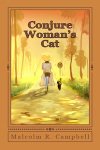 Malcolm R. Campbell is the author of the upcoming novella “Conjure Woman’s Cat” set in the Florida Panhandle in the 1950s days of the KKK and Jim Crow.
Malcolm R. Campbell is the author of the upcoming novella “Conjure Woman’s Cat” set in the Florida Panhandle in the 1950s days of the KKK and Jim Crow.

February 13, 2015
What a surprise: a well-written instruction manual
When I wrote computer documentation for many years, it was a point of honor–or perhaps the desire to keep my job–to write easy-to-follow documentation about complex subjects. I wished the technical writers at other companies took the same approach.
Lately, a lot of instructions are being supplied in foreign languages either without a translation or with the kind of translation one ends up with when using a free on-line translation application, as in:
Please to understand, unit is not to plug up nose or dangerous badness will happen.
Standard wall outlet is where you’re to be plugging in everything that you plug in unless your house does not provide power from generating plant. (Nose not included.)

This drawing actually includes explanatory text for each step.
That said, it’s a pleasure to take a new digital camera out of the box and, after noting all the dials, controls, gauges and other items that look like they’re Star Trek ready, it’s a relief to see that the instructions are: (a) easy to follow, (b) written in English, (c) include illustrations that actually match the gizmos on the camera.
So far, I’ve learned what most of them do even though I don’t yet know why I might want to do some of those things. The battery has been charged by plugging the charger into a standard all outlet that is getting standard power from North Georgia EMC rather than anyone’s nose.
It’s almost time to insert the battery and memory card into the camera and switch on the power switch. No pictures yet, but for a guy who grew up with Honeywell FILM cameras, digital cameras are about as natural a way for me to take pictures as nuclear physics. I need all the instructions I can get.
No pix yet, but soon.
–Malcolm
Malcolm R. Campbell, who no longer writes computer documentation, is now writing fiction. (Yes, I know, some operating manuals are fiction, possibly fantasy produced by sadists.)

February 10, 2015
Crossings, magical and otherwise
 There’s a railroad crossing on the cover of my upcoming novella Conjure Woman’s Cat because several incidents in the book occur at a crossing and crossings are associated with magic.
There’s a railroad crossing on the cover of my upcoming novella Conjure Woman’s Cat because several incidents in the book occur at a crossing and crossings are associated with magic.
The Florida Panhandle has traditionally been tied to the timber and turpentine industries. In the 1950s era when my book was set, pines, pulpwood, scraped trees with cups collecting resin for turpentine, and logging trains were common sights.
In modern times, we associate road crossings with red lights, traffic jams, hard-to-make left turns and accidents. Railroad crossings are places where drivers have to wait for trains and, by all means, stop, look and listen.
Crossings have always been associated with danger. Robberies happened there, armed men clashed there, and people got lost there.
All of this translates nicely into various forms of folk magic, including hoodoo, and in mythology. Like borders, crossroads were often considered to be uncertain places where realms, domains, countries and states of mind came together. Such places were often like oil and water in that they didn’t properly mix–“neither here nor there” folks often said. There is power at a crossroads, for good and ill.

quincunx – click on art for the Wikipedia page.
In hoodoo, the crossroads is the place where one summons demons and bargains for skills they need: in my novella, a young girl goes to a crossing to learn how to sing the blues. “Crossing” also refers to wavy lines an X mark (or quincunx) placed on the ground where one harms or shames another person through “foot-track magic.”
Powders and liquids used to jinx the path where the victim is expected to walk are said to enter or contact that person through the soles of his feet. Folks who know conjure, watch where they walk and also carry mojo bags, charms and other items to ward off evil.
Today we use the term “street wise” to those who know what to watch out for in the inner city; I think we can safely say one needs to be equally aware in a rural area where a root doctor (conjure woman) lives.

Railroad cars with logs – Saint Marks, Florida, photo by Johnson, State Archives of Florida, Florida Memory
Turpentine and pulpwood mean logging trains, a constant image in my book. People traveling the road into town see bulkhead flat cars at the railroad crossing heading for the paper mill. Where the tracks cross the road is also a tempting place to “lay a trick.”
I like the interplay of the magical and the real, and “crossings” (symbolic and real) offer a lot of “neither here nor there” kinds of places in a conjure story. A piney woods story wouldn’t be real without railroad crossings, bulkhead flat cars (typical for hauling wood) and turpentine stills.
I hope readers will enjoy the double meanings in the story as well the dangerous events that occur where one road (or railroad) crosses another road.
 You can read an interesting summary of crossings in hoodoo at the extensive Lucky Mojo site.�� (To Put on Curses, Jinxes, and Crossed Conditions, To Destroy Luck and Change Good Luck to Bad, For Revenge and Spiritual Antagonism).
You can read an interesting summary of crossings in hoodoo at the extensive Lucky Mojo site.�� (To Put on Curses, Jinxes, and Crossed Conditions, To Destroy Luck and Change Good Luck to Bad, For Revenge and Spiritual Antagonism).
You can read the Wikipedia overview of crossroads magic here and the post Mystery, Magic & Mayhem of the Crossroads here.
As always, I enjoy pulling the details and secrets of a place into my fiction and very much sharing the Florida world where I grew up.

February 5, 2015
The grand myth of John the Conqueror
Like King Arthur of England, he has served his people. And, like King Arthur, he is not dead. He waits to return when his people shall call him again … High John de Conquer went back to Africa, but he left his power here, and placed his American dwelling in the root of a certain plant. Only possess that root, and he can be summoned at any time. Zora Neale Hurston in “High John De Conquer”
When an author plunges into background information and themes for his stories, as I did while writing my upcoming novella Conjure Woman’s Cat, it doesn’t take long to discover mythic characters. John the Conqueror is perhaps the king of conjure, looming larger than life through blues songs, stories, root doctor herbal books, and an oral tradition dating back prior to the Civil War.
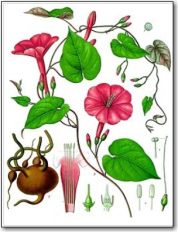
The roots of Ipomoea jalapa, when dried, are carried as the John the Conquer root amulet. – Wikipedia Photo
Today, conjure women–and those requesting their services–know a lot about the “three Johns,” the herbs named after the mythic hero:
The much sought after High John root, Ipomoea jalapa, is thought to create sexual power.
Southern John, from the Wake Robin, Trillium grandiflorum, used in medicine under the name Birth Root to facilitate childbirth and reduce menstrual cramps, is used in folk magic to solve family problems and love issues.
Chewing John (AKA Court Case Root) is Galangal, Alpinia galangal, used in medicine to reduce stomach ache and in folk magic to help a client prevail in court.
For information about spells, check here on the Lucky Mojo site.
The Myth
Charles W. Chesnutt’s 1899 book The Conjure Woman taught mainstream audiences about conjure in a fashion similar to the way Alan Lomax’s books taught them about true country music. Chesnutt collected stories. Lomax collected folk songs.
 Whether they trusted them or feared them, African Americans’ awareness of conjure women pre-dates slavery in America. Most White people knew little about the myths and practices of conjure before Chesnutt–and later, Harry Middleton Hyatt and Zora Neale Hurston–collected stories and put them into print.
Whether they trusted them or feared them, African Americans’ awareness of conjure women pre-dates slavery in America. Most White people knew little about the myths and practices of conjure before Chesnutt–and later, Harry Middleton Hyatt and Zora Neale Hurston–collected stories and put them into print.
Oral stories about John the Conqueror fed on themselves and on the hope such tales brought to slaves.
He was an African Prince
He was a slave
He played tricks on his masters and got away with it
Stories may have started with a real person
He was seen as a trickster like Coyote and Bre’r Rabbitt
Strange doings of unknown origin were attributed to him
The mythic prince/slave was seen as so powerful that, as Hyatt wrote in Folk-Lore from Adams County Illinois in 1835,�� “If you think that someone is trying to hoodoo you or do you some harm, and you meet them, walk backward six steps, spitting right and left, and saying, ‘John over John’–and, ‘John the conqueror’–and they can’t hurt you.” (The book is available in PDF.)
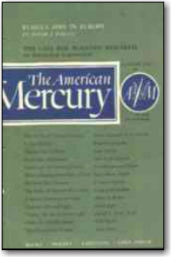 Hurston brought the myth into the modern day when she wrote, in a 1943 “American Mercury” article, “So the brother in black offers to these United States the source of courage that endures, and laughter. High John de Conquer. If the news from overseas reads bad, if the nation inside seems like it is stuck in the Tar Baby, listen hard, and you will hear High John de Conquer treading on his singing-drum. You will know then, that no matter how bad things look now, it will be worse for those who seek to oppress us…. White America, take a laugh from out of our black mouths, and win! We give you High John de Conquer.” The article is available in PDF.
Hurston brought the myth into the modern day when she wrote, in a 1943 “American Mercury” article, “So the brother in black offers to these United States the source of courage that endures, and laughter. High John de Conquer. If the news from overseas reads bad, if the nation inside seems like it is stuck in the Tar Baby, listen hard, and you will hear High John de Conquer treading on his singing-drum. You will know then, that no matter how bad things look now, it will be worse for those who seek to oppress us…. White America, take a laugh from out of our black mouths, and win! We give you High John de Conquer.” The article is available in PDF.
Conjure subjects fed into blues music and blues music supported conjure. White Americans learned about conjure through songs sung by such well-known artists as Willie Dixon, Muddy Waters and others. It should come as no surprise, then, that Dixon wrote a song called “My John the Conqueror Root.”
My pistol may snap, my mojo is frail
But i rub my root, my luck will never fail
When i rub my root, my John the Conquer root
Aww, you know there ain’t nothin’ she can do, Lord,
I rub my John the Conquer root
(Listen to Muddy Waters sing it here.)
As an author, I think it’s important to keep the old stories alive, whether they’re about King Arthur, John the Conqueror or Joel Chandler Harris’s Uncle Remus stories. They’re part of our culture and our history. Today, I suppose, most of the John the Conqueror focus is on the three roots and the qualities they have in the lore of folk magic.
I’m a novelist and don’t purport to be an anthropologist, much less a collector of myths and folktales. When we write ethically, the research we discover while planning a story isn’t pasted into the work like background music in an elevator. It helps shape the story and make it real. I’ll leave the theories to others and focus on storytelling with a much tradition as I can discover–and that includes John the Conqueror.
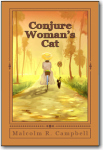 Malcolm R. Campbell’s novella, Conjure Woman’s Cat, will be released in March 2015 by Thomas-Jacob Publishing.
Malcolm R. Campbell’s novella, Conjure Woman’s Cat, will be released in March 2015 by Thomas-Jacob Publishing.

February 3, 2015
Unfolding a novel out of cluttered thoughts
Let’s say you have an idea for a story in which a 21st century man walks across Florida in search of the fountain of youth.
If you’re an organized person, you might rush to your computer, open a DOCX file and start creating an outline. If you’re a disorganized person, you might wander the blue highways of Florida for a few years and see what kinds of ideas come to mind. Maybe you’ll even find the fountain of youth.

We’d all be better writers if high school English teachers taught us the value of hunches.
I don’t advocate either approach. Outlines tend to restrict the story before it has time to take shape–that is, everything you don’t put in the outline tends not to be considered. Wandering tends to be addictive and pretty soon the story gets put off for a year or two and then a year of two more.
You’ve heard people say: “I was just thinking about Uncle Nat when he called up” and “My wife and I were wondering why we don’t see any red barns and then suddenly we begin seeing them everywhere.”
Whether you want to call it creating your own reality, fate, destiny or the focus of your awareness, thinking or researching one thing tends to draw similar things to mind. If you’re allowing your story to unfold, these similar things can add a lot to the plot, theme, characters and settings.
For example, while working on my upcoming novella about a conjure woman, I began finding multiple references linking conjure and the blues. I like the blues and so I looked further (trying not to wander and become distracted with my research) and found that many blues songs refer to conjure women or being “tricked” (hexed) or needing some good gambling MOJO.
These ideas enhanced the plot of my novella because blues songs and a juke joint became part of the story. Had I outlined the story in advance, covering the major ideas I had for it, I might not have found how well the blues fit what I needed to do.
Many writers I know tell me that when they research a subject–and don’t get in a hurry about it–the research leads them from one thing to another thing and suddenly (as though it’s destiny) they find something very crucial to their story. How? I don’t know. But the “how” doesn’t matter. The results are what matter.
If you’re writing a novel about a modern day Ponce de Le��n, reading about the historic person who purportedly sought the fountain of youth might generate ideas. Where in Florida did he go? Look at those places and keep your mind open for landforms, local legends, and perhaps a little history about the kinds of people who have lived there.
This might look like a waste of time because, after all, most of us were told in our high school English classes to start themes, book reports, term papers, etc. with many hours of work on an outline. Sooner or later, you might want to do this. When it comes to fiction, later (and possibly never) are better than sooner.
Let’s say the story you want to write has been nagging you to write it. Part of “writing it” is finding it. When it unfolds naturally, then you’ll probably end up writing the story you really wanted to write even though you didn’t know you wanted to write it the way it turned out when the idea first came to mind.
Writing that outline first has about as much chance of resulting in a good story as a marriage has of working out when you marry somebody during the first date before you know who they are.
 Malcolm R. Campbell is the author of “Emily’s Stories,” a three-story set about a young girl who allows her intuition to guide her so that she can solve problems her practical-minded parents can’t solve.
Malcolm R. Campbell is the author of “Emily’s Stories,” a three-story set about a young girl who allows her intuition to guide her so that she can solve problems her practical-minded parents can’t solve.

January 28, 2015
Out of the Darkness Walks – Team STRAT
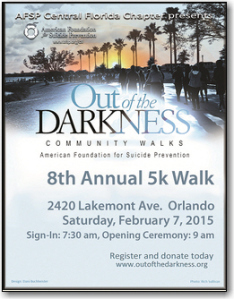 The Out of the Darkness Community Walks are the American Foundation for Suicide Prevention’s (AFSP) signature fundraising campaign, bringing together family, friends, colleagues, and supporters at 3-5 mile walks in hundreds of communities across the country.
The Out of the Darkness Community Walks are the American Foundation for Suicide Prevention’s (AFSP) signature fundraising campaign, bringing together family, friends, colleagues, and supporters at 3-5 mile walks in hundreds of communities across the country.
When you walk in the Out of the Darkness Community Walks, you join the effort with thousands of people to raise funds and awareness for AFSP’s vision to create a world without suicide.
from Barry Campbell:
We will be walking on February 7, 2015, for David Campbell (aka STRAT) – beloved son, father, rap artist, poet, and friend.�� He touched the lives of many and his footprints on their lives enhanced their world.�� Although we have lost him in life, he will live through his son Taylor, his poetry, his music, and many wonderful memories.�� He will be forever loved and remembered by his family and friends.
We will be joining with many other people to walk in the Orlando 8th Annual Community Walk, benefiting the American Foundation for Suicide Prevention (AFSP), and we would appreciate any support that you give for this worthwhile cause.

STRAT
The American Foundation for Suicide Prevention is at the forefront of research, education and prevention initiatives designed to reduce loss of life from suicide. With more than 39,000 lives lost each year in the U.S. and over one million worldwide, the importance of AFSP’s mission has never been greater, nor our work more urgent.
–
You can visit the Team STRAT page here. My wife and I miss David (STRAT) as well as his creativity expressed through his songs and poetry. And, like my brother and his wife, we enjoy watching David’s son Taylor growing up even though we live too far away from Orlando to see him as often as we would like.
These walks not only help raise funds but are walks of a million memories.
Malcolm





